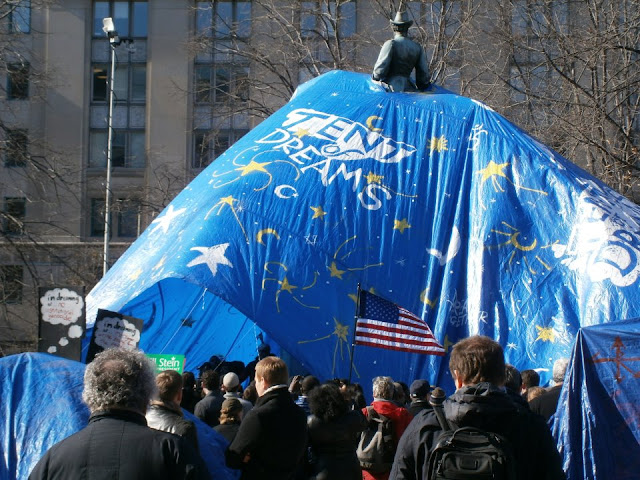Thousands of demonstrators from across the country descended on the Capitol this past Tuesday to partake in the Occupy movement’s latest evolution –
Occupy Congress. The protests took place on the day that lawmakers returned to Washington amid historically low approval ratings.
I hopped on the Metro after work and arrived at the Capitol South Station (the closest station to Congress) and was dismayed to see the station plastered with dirty energy ads from the American Petroleum Institute. The “I Vote 4 Energy” campaign is a cynically misleading attempt by the oil and gas industry to influence policymakers by falsely representing domestic fossil fuel production as a job creator and something a majority of Americans support.
Click here for a detailed take down of API’s ad campaign from the website Political Correction. Contrary to Big Oil’s propaganda, a
study conducted by the Yale Project on Climate Change Communication and George Mason University Center for Climate Change Communication last November on public support for energy and climate policies revealed that 90% of Americans believe developing sources of clean energy should be a very high to medium priority for the president and Congress; and 69% of Americans oppose federal subsidies to the fossil fuel industry. So the oil and gas industry is right about voting for energy, they are just wrong about the type of energy. Americans want clean renewable energy, not dirty fossil fuels.
And a renewable energy policy is but one of many issues Congress has failed to address, which is why the west lawn of the U.S. Capitol was full of people protesting the undue influence big money lobbyists like the American Petroleum Institute have on congressional lawmakers. A rainy, dreary Washington winter day transformed into a clear, starry night as live folk music lifted the spirits of thousands of Occupiers gathered in the muddy grass in the shadow of the brightly lit Capitol dome.
Soon after I arrived the majority of protestors left for a march to the Supreme Court and White House (on Friday a group called
Move to Amend marked the two year anniversary of the Supreme Court’s
Citizens United decision with rallies at courthouses across the country.)
I interviewed Vince from Durham, North Carolina, asking him why he came up to D.C. for Occupy Congress.
“I’m here to support what I think is going on here, which is a lot of inequality and injustice between the wealthy and the rest of the people. I have no problem with wealthy people, it’s just that the system is kind of skewed, so it makes it not only really bad for us but ultimately it’s going to be bad for them as well as it keeps going forward and forward. You’ve got to have customers to buy your stuff.”
Here are a few of my general observations about the Occupy movement so far. I’ve walked through the Freedom Plaza and McPherson Square encampments in Washington, D.C. and Zuccotti Park in New York City multiple times and now have experienced Occupy Congress.
* The Occupy movement has been criticized for remaining leaderless and issueless. But that is the most brilliant aspect of this movement and what has allowed it to remain relevant and constantly evolving. The Occupy movement cannot be pigeonholed into just another special interest group or coopted by a political party or corporation like the Tea Party was corrupted by the Koch brothers and the Republican Party. The fact that Occupy has not been absorbed into the Democratic Party and has refused to be defined by a narrow agenda is exactly what has kept it so vital. Its populist 99% slogan is all it really needs because everyone brings their own issues and points of view to the table.
* Beyond the issues, the Occupy movement (and even the Tea Party movement before it was hijacked by right-wing businessmen and conservative Republicans) spawned from an underlying sense that something isn’t right in America. Poll after poll shows Americans believe the country is on the wrong track and there is deep distrust and resentment towards the political and economic establishment. The feeling that we have lost our way and that we need to get back to being great again is a prime motivator of this populist movement. The Occupy movement will last until the majority of Americans regain confidence in our political and economic systems.
* I’m still shocked that the Occupy movement has even taken place at all. I thought the economic crisis was not bad enough yet and that most Americans were too pacified by our crass commercial culture and media circus to get off our couches and take to the streets. I thought it would have to get to Great Depression levels with Hoovervilles again, which was the current trajectory we were on until Obama saved us from falling over the cliff. America is actually really lucky the Occupy movement is taking place right now and pushing leaders to take action so we not only avoid a Great Depression, but power out of this seemingly never-ending Great Recession and restore American Democracy and the American Dream for future generations.





